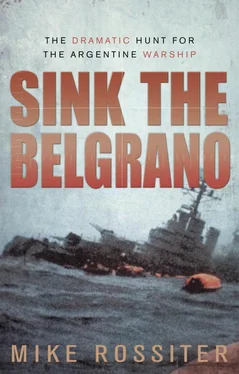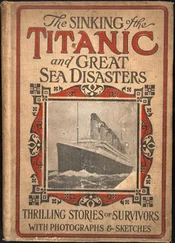It wasn’t so easy to find other members of the crew. Some of them didn’t get phone calls with orders to return to Faslane until 1 April, and these messages were often treated as an April Fool’s joke. Graham Libby, one of Conqueror ’s divers and the senior sonar operator, who had served on the submarine since 1979, was at home in Portsmouth, having been one of the first to go on leave.
I had only been there for a few days when there was a knock on the door and there was this policeman stood there saying, ‘You’ve been recalled. Make your way back to the boat.’ It was the morning of April the first he knocked on the door, and I thought this is a wind-up, April fool, so I phoned the boat up in Faslane, and they said, ‘Yeah, it’s true – you’re recalled.’ When I got there it was just a hive of activity. There were stores on the jetty, there was a complete new weapons load, everybody was running around, and I thought this is not a wind-up, this is not an exercise, something’s going on here.
By the time that Graham Libby arrived at Faslane, all the officers and most of the crew were desperately struggling to store for war, and to find out what their mission was and how they were expected to carry it out. Storing for war meant taking twice the amount of provisions on board than was necessary for a normal patrol. The process involved double-decking, where tins of food were placed on the decks and then hardboard was laid over the tins as a temporary floor. As Graham Libby explained:
You’re limited in headroom anyway; you’re now limited by a fifteen-inch layer of tinned food. So you eat your way through the floor once all the fresh food has gone or perished. Even just looking at all this extra food, you knew you were going for a long time.
Faslane, in fact, was extremely busy. HMS Splendid had been recalled from her mission to locate a Soviet submarine in the Atlantic, and was tied up at the quay loading a full complement of torpedoes. Her captain, Commander Roger Lane-Nott, had orders to make the best possible speed to the Falkland Islands:
I received a signal from the First Sea Lord detailing events in the South Atlantic. We had to pull off the Russian sub, head back to Faslane, and put on stores. I arrived at about nine or ten at night, we loaded up and eighteen hours later we sailed under some secrecy.
By now it was clear to most of the crew of Conqueror that there was a problem of some sort developing in the Falklands with the Argentinians, and that was where they were going. In the week before the telephone call to David Hall there had been stories in the news that some Argentine soldiers, or workmen – it was unclear what they were precisely – had landed on a remote island in the middle of the South Atlantic called South Georgia, which was British territory, and had raised the Argentine flag. Now there were unconfirmed rumours that Argentine warships were heading towards the Falkland Islands – another British possession, with a population of two thousand British citizens – with the intention of invading them. There seemed to be no logic to these events, and it was hard to see how Conqueror could make any difference to what was happening 8,000 miles away. It took some time for a lot of people actually to work out where the Falklands were. One crewmember recalled thinking, ‘What are the Argentinians doing off the coast of Scotland?’
The commanding officer of Conqueror , Commander Christopher Wreford-Brown, was new to the boat and had thought that he might have time to get to know the crew, many of whom, like Graham Libby or Petty Officer Writer Colin ‘The Bear’ Way, had served on the boat for several years. As someone remarked, ‘He hardly knew the names of the members of the wardroom, let alone anyone in the junior ratings mess.’ But now he was ensconced in meetings on shore trying to get as many details of his mission as he could, and under intense pressure to put to sea as quickly as possible. His conversations with David Hall were fraught as the engineer fought against his extremely truncated maintenance period of ten days being shortened any further, but David was astounded at the complete shift in the attitude of the naval bureaucracy. To get essential spare parts, it was no longer a question of endless form-filling and requisitions, to be met with the answer that they would take ten weeks to arrive. Instead, whatever he wanted was offered to him immediately, with some hard-to-get pieces of equipment sent by helicopter if necessary. He could have rebuilt the whole boat if he had time, but that was the one thing that wasn’t available to him. Under continual pressure, his original five-week maintenance period was squeezed to five days. Charlie Foy remembers the process as one mad rush, where as much equipment as possible was taken on board for any foreseeable emergency, and work replacing machinery went on twenty-four hours a day.
It was customary that both the commander and the second officer on a nuclear submarine should be command-qualified, and Lieutenant Commander McClement had also just recently passed his Commander’s Course. As a colleague remarked, ‘He was nails dug in, dead keen to prove himself.’ He was, however, only an acting lieutenant commander, whereas the chief engineer was a full commander, very much senior in rank. When McClement had first joined Conqueror Commander Hall had taken him aside and said, ‘You’re second in command and I’ll back you in the wardroom, if you will do me the favour of listening to me if I think I can give you some advice.’ They had got on well ever since. Both were curious to find out what their new commanding officer was like.
Lieutenant Commander McClement had other worries as well. Petty Officer Charlie Foy was returning to the submarine one night when he saw a bus parked next to the boat with the words ‘Royal Marine Free Fall Parachute Team’ painted on the side. Conqueror was embarking a group of the SBS, the Special Boat Service.
The Special Boat Service was a small group of Special Forces drawn solely from the Royal Marines. As a unit, they were not as famous as the other group of Special Forces, the Special Air Service, or SAS. The SAS had become well known because of their operations in Northern Ireland, and most recently for their role in the 1980 Iranian Embassy hostage crisis in London. A group of Iranian students, opposed to the rule of Iran’s leader, the Ayatollah Khomeini, had taken nineteen hostages in the embassy in Kensington. Members of the SAS had abseiled down the front and back of the building, smashing through windows, throwing stun grenades and firing machine pistols. The whole event, broadcast live on television, had been as thrilling as anything Hollywood could produce.
Compared with this, the SBS had a non-existent public profile, but they considered themselves just as highly trained and had been in action in Suez, Aden, Malaysia and Indonesia. They had been formed after the Second World War from some rather esoteric groups. One of them was the Special Boat Section, which was part of an army commando unit. Then there was a small group of marines called the Combined Operations Pilotage Parties, formed in 1942, who were responsible for the clandestine surveillance and charting of possible landing beaches for the Allied invasions of Sicily and France. A third group, whose exploits were the best known, was the Royal Marines Boom Patrol Detachment. This last group, despite its prosaic name, was formed to mount attacks on enemy ships in port. Their most famous operation was an incursion by canoe into Bordeaux harbour with limpet mines, damaging six merchant vessels. Only two men survived, Blondie Hasler and Ned Sparks; a memorial to the ten who died was erected at the SBS headquarters in Poole, Dorset, and a feature film about the mission, The Cockleshell Heroes , was made after the war.
Читать дальше












